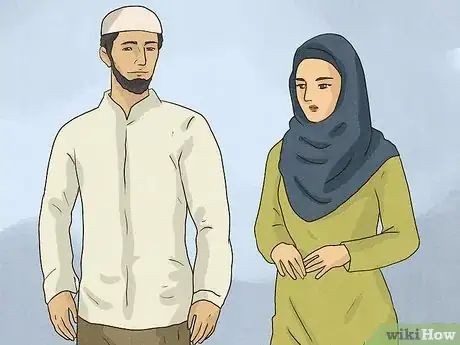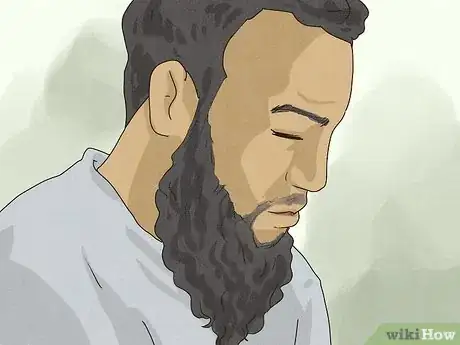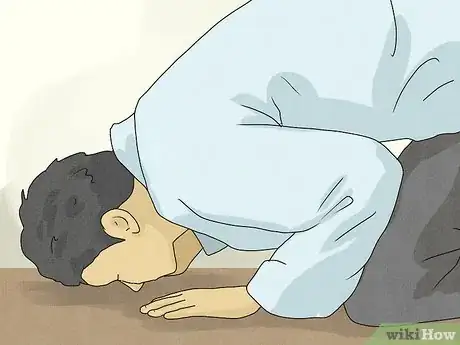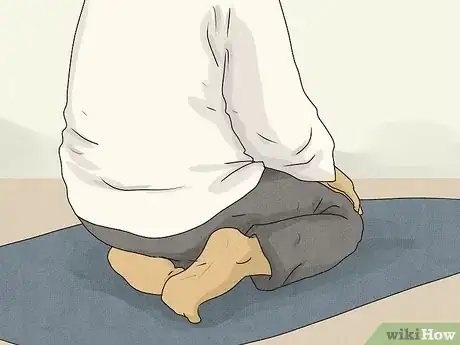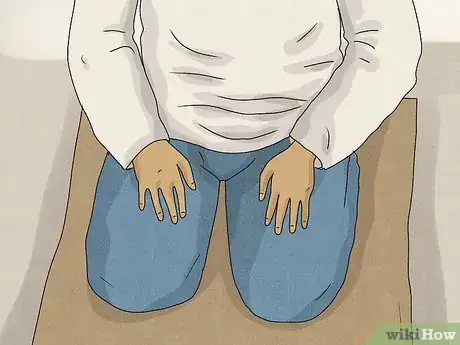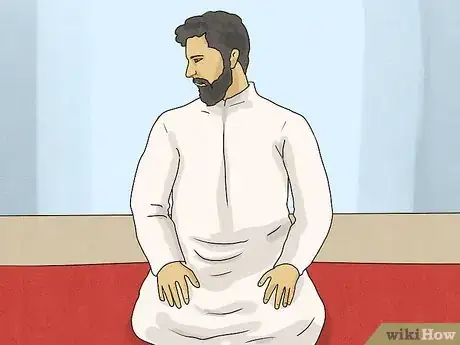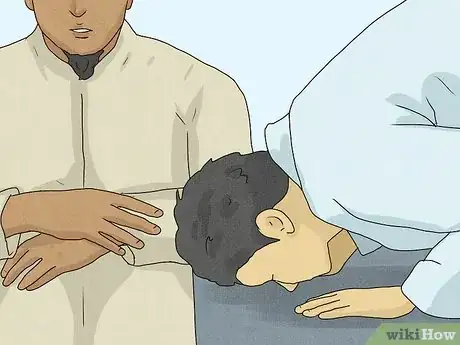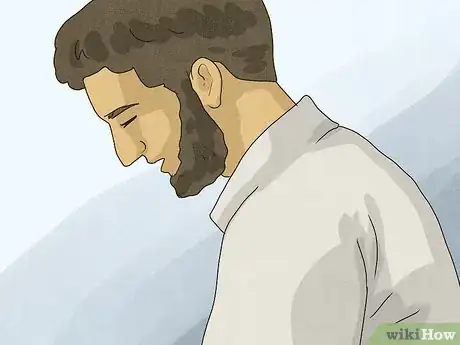wikiHow is a “wiki,” similar to Wikipedia, which means that many of our articles are co-written by multiple authors. To create this article, 9 people, some anonymous, worked to edit and improve it over time.
There are 9 references cited in this article, which can be found at the bottom of the page.
wikiHow marks an article as reader-approved once it receives enough positive feedback. In this case, 94% of readers who voted found the article helpful, earning it our reader-approved status.
This article has been viewed 687,873 times.
Learn more...
Taraweeh is the sunnah prayer that is performed after the 'Isha (night) prayer in Ramadan. It is a very virtuous act of worship; the Prophet (peace be upon him) narrated that, "he who observes optional prayer (Tarawih prayers) throughout Ramadan, out of sincerity of Faith and in the hope of earning reward will have his past sins pardoned."[1] Men are encouraged to attend Taraweeh prayers at their local mosque. Women, as well as those men who are unable to attend the congregational Taraweeh, are able to pray the Taraweeh prayer at home. Read on to find out how to do so!
Steps
Preparing for Prayer
-
1Decide how many rak'ah you are going to prayer. A rak'ah is a unit of prayer. It's up to you how many raka'h you would like to pray; some people eleven, thirteen, or even twenty rak'ah. As long as you pray your rak'ah two by two, and conclude it with the Witr prayer, this is following the sunnah.
- It was narrated by one of the companions of the Prophet (peace be upon him) that "he performed the night prayer in pairs (i.e., Rak'ah) and made it odd number by observing one Rak'ah (as Witr)."[2]
-
2Ensure the area is clean and free of impurities. This includes your body, your clothes, and the place of prayer itself.
- Perform wudu. You must be ritually pure before you go start praying. If you're not, it's required to perform Wudu before you do. If since your last prayer, you have urinated, defecated, passed gas, bled excessively, or fallen asleep while leaning against something, you need to perform wudu[3]
- If you are praying in a masjid (mosque), which is highly encouraged for men, enter quietly--other fellow Muslims might still be praying and you don't want to disturb them. Stand in a free space away from the entrance/exit.
- If you are unsure of the cleanliness of your area, spread a mat or cloth on the floor for good measure. This mat (or prayer rug) is very important to Islamic culture.
Advertisement -
3Perform ghusl (full shower) if needed. Certain circumstances will require that you perform ghusl instead of wudu to be cleansed after removing najas (impurities) and before praying. If you wish to pray after having sexual intercourse, ending your menstruation period or postpartum bleeding, giving birth, or ejaculating, you need to perform ghusl. [4]
- To perform ghusl, you must wash your entire body and hair with water. It is recommended that you wash 3 times.
- Note that when you perform either wudu or ghusl, anything that prevents water from touching the obligatory areas of the body must be removed, including things such as nail polish, accessories, and waterproof mascara.[5]
-
4Perform tayammum (dry purification) if needed. If a Muslim is unable to use water, he or she may choose to perform tayammum instead of wudu or ghusl. This rite involves using clean soil or dirt that has not been used before to perform tayammum.[6]
-
5Face the Qibla. This is the direction all Muslims face to turn in prayer towards the Holy Ka'bah. The Holy Mosque in Mecca is the most revered place of worship for Muslims around the entire world. All Muslims are required to face the Ka'bah five times every day when offering their prayers.
-
6Cover yourself. Men and women must both cover themselves with material that covers the skin throughout the prayer. While women must cover everything but their faces and hands, men must keep the area between their navel and knees covered.[7]
- The material must cover the body during prayer movements. So if, for example, bending causes a piece of material to slip and expose skin on a woman’s neck, she would need to ensure that her clothing is tucked in properly or put more clothing on before she can complete her prayer.
Performing Taraweeh
-
1Make the intention of Taraweeh. You do not need to pronounce it vocally, but have the intention in your mind that you are praying Taraweeh.
-
2Raise your hands up to your ears and say Allahu Akbar. This translates to "Allah is the greatest."
- If you cannot stand up for medical reasons, you are allowed to sit down.
- There is an alternative opinion that the hands should be raised to the shoulders. Both ways are valid.
-
3Place your right hand over your left hand. Place your hands either on your navel, on your chest, or between the two; there's difference of opinion between Islamic schools of jurisprudence. Again, all opinions are valid.
- As you have commenced the prayer, you must keep focused. It's recommended to fix your eyes on the place of prostration so that you don't look around.
- It's greatly disliked to look up when praying. The Prophet (peace be upon him) said, "People must stop raising their eyes to the heaven... during prayer, otherwise their sight will be taken away."[8]
-
4Recite the Du'a al Istiftah. This is the opening du'a. It is "subhanakal-lahumma, wabihamdika watabarakas-muka wataala, judduka wala ilaha ghayruk". Then say, "a’auodu billaahi minash-shaytaanir rajeem, bis-millaahir rahmaanir raheem".
-
5Recite Surah al Fātiḥah. This is a key component of the prayer. It must be recited in each of the two rak'ahs of Taraweeh. It is "Alhamdu lillahi rabbi 'aalameen; Ar-rahmanir raheem; Maaliki yawmid deen; Iyyaka na'budu wa-iyyaaka nasta'eeen; Ihdinas siraatal mustaqeem; Siraatal latheena an'aamta 'alayhim; Ghayril maghdoobi 'alayhim walad dhaalleen".
-
6Recite any other surah. It is encouraged for someone who has memorised the Qur'an to make each rak'ah lengthy by reciting a long surah. However, if you do not know that many surahs, you can recite the ones that you know, as long as you recite them in the correct order.
-
7Say "Allahu Akbar" and bend down. This is the ruku' position. Try to make your back as straight as possible, and relax your body. Your body does not need to be a perfect 90-degree angle.
- While bowing, say, Subhanna Rabbiyal Adheem three times. This means "Glorious is my Lord, the most great."
- Some schools of jurisprudence say that you should raise your hands and then go into ruku', while others do not. Both are valid opinions.
-
8Raise from ruku'. While rising up, recite Sami-allah Huliman Hamidah . This means "Allah hears those who praise Him".
- While standing up, recite Rabana Walakal Hamd (Our Lord, all praise is for you) once. You can also add Hamdan Katheeran Tayyiban Mubaarakan Feeh" (praise which is abundant, excellent and blessed) after.[9]
- Some schools of jurisprudence say that you should raise your hands after you have raised back up, while others do not. Both are valid opinions.
-
9Say Allahu Akbar and prostrate. This is the sajdah position. Place your head, knees and hands on the floor.
- When you are positioned fully, say Subhanna Rabbiyal A'laa (Glorious is my Lord, the most High) three times.
- Your forearms should not be on the floor.[10]
- Some schools of jurisprudence say that you should go into sajdah with your knees first, while other say you should go into sajdah with your hands first. Both are valid opinions.
-
10Rise from sajdah and sit on your knees. Place your left foot from ball to heel on the floor. Your right foot should be toes on the floor only. Place your hands flat on your thigh. You can recite Allaahumma-ghfir lee warhamnee wajburnee, warfa’nee, wa 'aafinee war'zuqnee (O Allah, forgive me, have mercy on me, strengthen me, raise me in status, pardon me and grant me provision).
- There are other du'as that you can recite in this position, such as Allahuma-ghfirlee twice (O Allah, forgive me).
- Return to sajdah and say Subhanna Rabbiyal a'laa three times.
-
11Say Allahu Akbar and stand up. You have completed one rak'ah and you will need to complete another rak'ah in the exact same way.
-
12After the second sajdah in the second rak'ah, stay sitting. You need to recite certain du'as in this sitting position.
- Tashahhud: At-tahiyyaatu Lillaahi wa-salaawaatu wa-tayyibaat. As-salaamu ‘alayka ayyuha-Nabiyyu wa rahmatullaahi wa barakaatuhu. As-salaamu ‘alayna wa ‘ala ‘ibaad-illaah-is-saaliheen. Ash-hadu al-aa ilaaha ill-Allaah wa ash-hadu anna Muhammadan ‘abduhu wa rasooluhu
- "All compliments, prayers and pure words are due to Allaah. Peace be upon you, O Prophet, and the mercy of Allaah and His blessings. Peace be upon us and upon the righteous slaves of Allaah. I bear witness that there is no god except Allaah and I bear witness that Muhammad is His slave and Messenger".
- Durood: Allaahumma salli ‘ala Muhammad, wa ‘ala aali Muhammad, kama salayta ‘ala Ibraaheem, wa ‘ala aali Ibraaheem, innaka hameedun majeed. Allaahumma baarik ‘ala Muhammad, wa ‘ala aali Muhammad, kama baarakta ‘ala Ibraaheem, wa ‘ala aali Ibraaheem, innak hameedun majeed
- "O Allaah, send prayers upon Muhammad and upon the family of Muhammad, as You sent prayers upon Ibraaheem and the family of Ibraaheem, You are indeed Worthy of Praise, Full of Glory. O Allaah, bless Muhammad and the family of Muhammad as You blessed Ibraaheem and the family of Ibraaheem, You are indeed Worthy of Praise, Full of Glory".
- Tashahhud: At-tahiyyaatu Lillaahi wa-salaawaatu wa-tayyibaat. As-salaamu ‘alayka ayyuha-Nabiyyu wa rahmatullaahi wa barakaatuhu. As-salaamu ‘alayna wa ‘ala ‘ibaad-illaah-is-saaliheen. Ash-hadu al-aa ilaaha ill-Allaah wa ash-hadu anna Muhammadan ‘abduhu wa rasooluhu
-
13Finish the prayer with tasleem. Turn your head to the right, and then the life, while saying "'As-salamu alaykum wa Rahmatullah".
-
14Continue praying two-by-two until you are satisfied. You can read how many rak'ahs you are comfortable with. People commonly pray nine, eleven or thirteen rak'ahs, but you can read more or less. Allah (subhanahu wa ta'ala) says in the Qur'an regarding the night prayers, "Your Lord knows that you sometimes stand up in Prayer nearly two-thirds of the night, and sometimes half or one-third of it... Recite, then, [only] as much of it as you may do with ease".[11]
-
15Conclude the Taraweeh with the Witr prayer. When you've prayed your two-by-two rak'ahs, you need to round it all off by praying an odd number of Witr rak'ahs. Most commonly, people pray one or three rak'ah Witr. For example, they'll pray 12 rak'ahs of Taraweeh, then one rak'ah of Witr to make it 13 rak'ahs in total.
Community Q&A
-
QuestionDo I say the tasleem in three intervals or every rakah, or do I do it at the end of the taraweeh prayer or say 12 rakahs?
 Community AnswerPray taraweeh in 2 rakaats. For example, on the second rakaat, then give salaams.
Community AnswerPray taraweeh in 2 rakaats. For example, on the second rakaat, then give salaams. -
QuestionAm I allowed to use my phone for reciting while praying Tahajjud, as I have not memorized the holy Qur'an?
 Black And Blue GamingCommunity AnswerYes, you can. There are very good Islamic sites on the internet, and it is no problem to use them.
Black And Blue GamingCommunity AnswerYes, you can. There are very good Islamic sites on the internet, and it is no problem to use them. -
QuestionI've watched a video in which they said after Tashahud, you recite a dua (of taraweeh) followed by salaam. Reciting Darood Ibrahim isn't mentioned in the video. Is it wrong?
 SobiTop AnswererThat is not something I have heard of, nor is it the position of any of the schools of thought as far as I am aware. Some scholars take the opinion that Durood Ibrahim (salawat) is sunnah, while others say it is fardh.
SobiTop AnswererThat is not something I have heard of, nor is it the position of any of the schools of thought as far as I am aware. Some scholars take the opinion that Durood Ibrahim (salawat) is sunnah, while others say it is fardh.
References
- ↑ https://muflihun.com/riyadussaliheen/9/197
- ↑ https://muflihun.com/riyadussaliheen/9/179
- ↑ http://www.huffingtonpost.com/imam-khalid-latif/how-muslim-prayer-works_b_909127.html
- ↑ http://www.sunna.info/prayer/TheBasicsoftheMuslimsPrayer.php
- ↑ http://www.sunna.info/prayer/TheBasicsoftheMuslimsPrayer.php
- ↑ http://www.sunna.info/prayer/TheBasicsoftheMuslimsPrayer.php
- ↑ http://www.sunna.info/prayer/TheBasicsoftheMuslimsPrayer.php
- ↑ https://sunnah.com/abudawud/2/523
- ↑ http://salafus-saaliheen.blogspot.co.uk/2011/11/hamdan-katheeran-tayyiban-mubarakan.html
About This Article
To pray the Taraweeh prayer at home, start by ensuring that you and the area around you are clean and free from impurities. You should also cover yourself and face the Qibla. When you're ready to begin, make the intention of Taraweeh, raise your hands to your ears, and say, "Allahu Akbar," then place your right hand over your left hand. Next, recite the Du'a al Istiftah and Surah al Fātiḥah. Once you're done, say "Allahu Akbar" and bend down into ruku' position. When you rise back up from ruku', recite "Sami-allah Huliman Hamidah," then say "Allahu Akbar" again and get into sajdah position. From here, you can complete this rak'ah by saying "Allahu Akbar" and standing up. Finally, perform another rak'ah and finish the prayer with tasleem and the Witr prayer. For more advice, including how to perform ghusl, keep reading!





